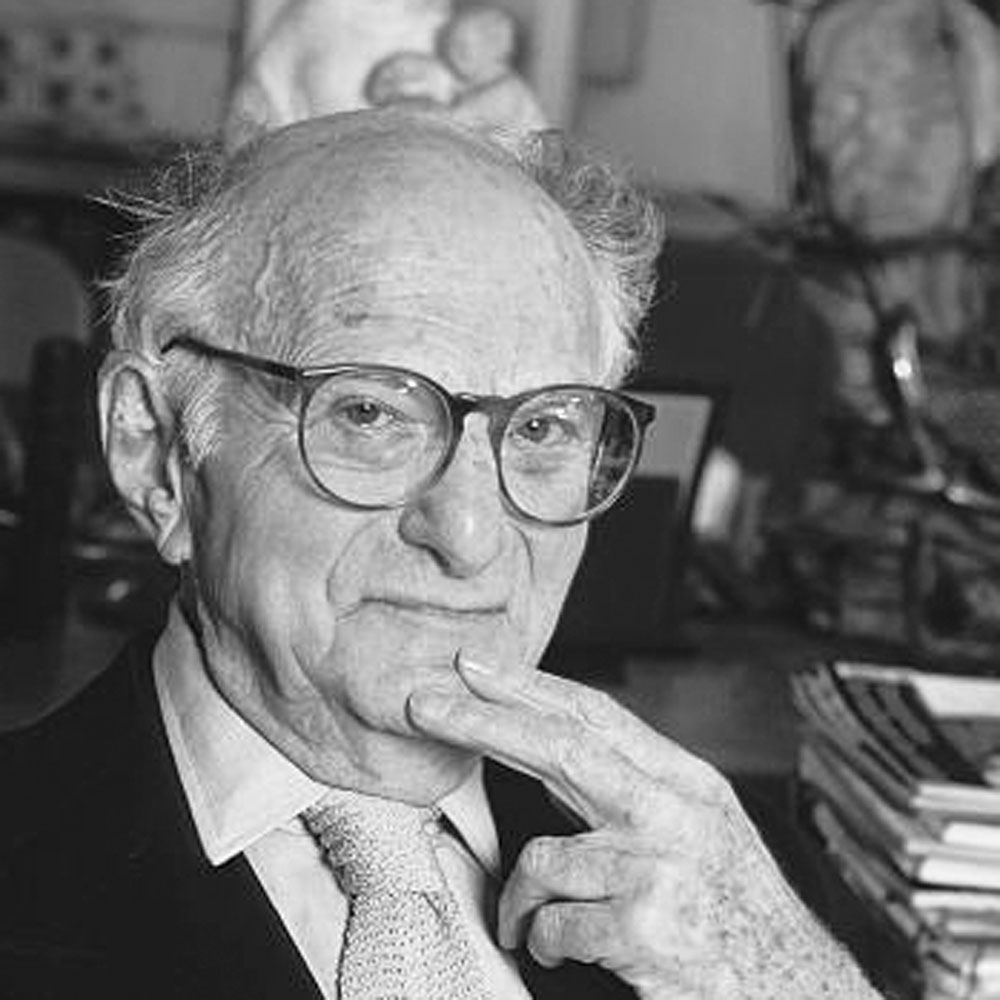PAR MAURICE RHEIMS

Chacun voit dans une oeuvre d’art ce que le créateur suggère à sa sensibilité propre. Mais il faut plus que du talent pour métamorphoser celui qui voit en voyeur. C’est la marque absolue de la grâce, que d’inviter l’oeil à la caresse. Ces corps féminins, si offerts, si vivants, enferment dans les renflements de la matière une âme volage, la science du mouvement lent, l’attente du désir encore inassouvi. Leurs sinuosités épousent la tension de la sève, la plénitude de la possession. En animant le bronze d’un contenu charnel, Pollès possède le pouvoir de mêler le souffle de la sensualité à l’ardent ouvrage du forgeron.
Le bronze est plus fragile, plus susceptible que la peau. Sa patine est son seul vêtement, si précieuse, si délicate qu’il faut se contenter de la toucher de l’oeil, sans jamais l’effleurer du doigt.
Devant ces femmes aux noms de déesses païennes, pulpeuses, ouvertes, devant ces explorations de l’harmonie des corps, mon imaginaire se plaît à croire qu’un brandon s’est échappé du bûcher destiné à anéantir les diablesses, les sorcières, pour enflammer l’atelier et ses modèles. De l’étonnant contraste entre ce travail de la matière, cette obstination à forcer la dureté minérale et les formes lisses et rondes qui en résultent, naît sans doute cette impression de douceur et de force, de tendresse et de sauvagerie mêlées en une rythmique si particulière.
A ce propos, j’évoquerai la modernité, idée qui voisine avec celle de la Beauté depuis les origines de la création, qu’au cours des temps les curieux ont cru tenir entre les mains devant les oeuvres du Bernin, de Rodin, de Pompon, de Giacometti, sans que jamais elle ne livre son mystère. Si ma pensée associe des artistes si dissemblables, c’est qu’ils appartiennent tous à cet Olympe de l’imaginaire créateur, qu’ils ont tous réussi à dérober une part du feu céleste. Si le projet, la manière, la main, l’inspiration diffèrent, ils ont en commun d’avoir cherché et trouvé chacun sa parcelle des secrets de ce qu’aux siècles passés on nommait le Grand Beau. Il me semble en avoir décelé la présence dans l’oeuvre de Pollès. Pour moi, le forgeron fait partie du panthéon des initiés : drôle de bonhomme, qui manie le bronze, si lourd, avec autant de grâce que s’il arrachait une plume sur le ventre d’un cygne, pour la modeler, la sculpter, la polir, dans la fusion des substances et des fantasmes.
Maurice Rheims
de l’Académie française
ENGLISH VERSION

Each spectator finds in a work of art what its creator suggests to his or her personal sensitivity. But it takes more than just talent to transform a viewer into one who sees. The ability to draw the eye into contours of these womanly bodies, so alive and so openly offered, enfold a mercurial soul,the deep intuition of slow movement the anticipation of as yet unfulfilled desire. Their sinuous lines are in confluence with the tensionof rising sap,the plenitude of possession. Pollès’s power of giving life to the bronze by infusing it with a carnal quality enables him to combine the breath of sensuality with the gloving work of the metal-smith.
Bronze is more fragile, more vulnerable than skin , its patina is its only garment, so precious and delicate that it can be touched only by the eyes with never so much as the lightest caress of a hand in the presence of these luscious, open women named for pagan goddesses, faced with these explorations of bodily harmony, my fancy imagines that the workshop and its models have been set aflame by a fiery spark from a pyre built to destroy she-devils and witches.
The impression of gentleness and strength, of tenderness and wildness intertwined in such a unique rhythmic pattern must surely arise from the stunning contrast between Pollès’s handling of the raw material, his unylelding determination to bend the obdurate mineral to his will, and the smooth, rounded forms that finally emerge.
Thinking of this brings me to the idea of modernity, which has been contiguous to the notion of Beaty since the origin of creation. Although enquiring observers have at various times belleved it to have been captured in the works of Bernini, Rodin, Pompon or Giacometti, its mystery has nonethless never been truly revealed. My mental association of such disparate artists can be attributed to the fact that they all belonged to the Olymplan heights of creative imagination, and all succeeded in appropriating a share of the holy fire. Despite the disparatities in their aims, manner, touch and inspiration, they share the common factor of having searched for and discovered, each in their individual way, their own fragment of the secrets that were part of what in bygone times was thought of as the quintessence of Beauty. I sense its presence in the work of Pollès. In my mind this moulder of metal has taken his place among the illustrious initiates; a curious man, who handles the immensely heavy bronze with the elegant ease of one plucking down from a swan’s breast, shaping, sculpting and burnishing it into a blend of substances and fantasles.
Maurice RHEIMS
Member of the Académie française
POLLÈS PAR MAURICE RHEIMS
Je l’ai dit, je l’ai écrit, je tiens Pollès pour l’un des plus remarquables sculpteurs de notre temps.
PIus il m’arrive de voir de ses figures plus elles m’enchantent, comme si depuis Ieur création elles n‘avaient jamais cessé d’étre exposées patinées sous des cascades d’eau à Tivoli. Chacune se pliant amoureusement aux exigences de l’artiste, évoquant lèvres, torses, gonflés de désir et de liesse. C’est dire le bonheur pour I’œil, pour la sensibilité du promeneur qui,à Bagatelle, tourne et retourne tant fasciné par ses Yterbine, ses Aspasie, ses Nathanaël ; et, pour démontrer son génie créateur, PolIès s’en joue aussi bien sur ses bronzes patinés que sur ses marbres.
Depuis l’origine de l’art, on n’a eu de cesse de traduire notre sensibilité dans la pierre ou sur des supports ; ainsi, l’imagier peut justement se targuer d’étre I’amant de I’art. En méme temps, parce que la gouge, le maillet, le four, sont plus difficiles à maìtriser que la peinture ou le dessin, de temps en temps il lui arrive de céder au découragement.
Zola, dans l’Œuvre, donne la parole à un sculpteur « Ah, quel chien de métier que cette sculpture! Le dernier des maçons était plus heureux. La sculpture est le plus noble, le plus viril, oui ; mais l’art dont on crève le plus sûrement de faim ».

Ce que le romancier ne signale pas, c’est la difficulté que rencontre le sculpteur à être de son temps. Celui d’hier s’essouffle à la recherche de plus de modernité. S’il y parvient, son œuvre sera symbole d’avant-garde, situation ardue parce qu’il risquera d’être en butte à la critique. Ajouter à cela la difficulté ressentie à toute idée de classement ; ainsi, éprouve-t-on du mal à discerner – particulièrement quand ils sont accomplis – entre Ies ouvrages exécutés par Ies Grecs au Vème siècle avant notre ère d’avec ceux des Romains du III ème. Deux millénaires plus tard, on aura bien du mal à trouver ce qui sépare Houdon de Canova. En cette fin du XXème siècle, la sculpture de PoIIès, forte et ondoyante, mérite particulière attention tant déjà il a fait d’adeptes.
ENGLISH VERSION
POLLÈS BY MAURICE RHEIMS
As I have said and written before, I consider Pollès to be one of the most outstanding sculptors of our time.
The more often I see his figures, the more I am enchanted by them:it is as though they had been exposed to wind and weather under thewaterfalls of Tivoli since the moment of their creation, each workbending amorously to the artist’s demands, evoking lips, torsos,bursting with desire and rejoicing. This gives an idea of the visual andsensual pleasure offered to strollers in the Bagatelle park who, time and again, walk fascinated around his Yterbine, Aspasie and Nathanael;and in demonstration of his creative genius, Pollès handles his patinated bronzes with the same ease and assurance as he does in hiswork in marble.
Since the origins of art, our sensitivities have always been translated into stone or onto some support: the sculptor can therefore justifiably claim to be the lover of art. At the same time, because the chisel, mallet and furnace are more difficult to master than painting or drawing, he sometimes becomes discouraged.

In « The Masterpiece », Zola gives voice to a sculptor: « What a devil of a job sculpture is! The lowliest of stonemasons is better off. Sculpture is certainly the noblest and most virile of the arts, but it’s the one that most surely leads to hunger ».
What the novelist does not mention is how difficult it is for a sculptor to be in harmony with his times. Previously, the sculptor would expend great energy in seeking greater modernity, but when he achieved this his work became symbolic of the avant-garde, which put him in the difficult situation of being the target of criticism. Added to that are the problems inherent in the idea of classification, which are such that it is hard to differentiate between works made by Greeks and those done by Romans in the 5th and 3rd centuries B.C. respectively – especially when they are of good quality. Two millennia later it is not a simple matter to distinguish between works by Houdon and Canova. As the 20th century draws to a close, so many adepts have been generated by the powerful, undulating sculpture created by Pollès that his work is worthy of particular attention.
